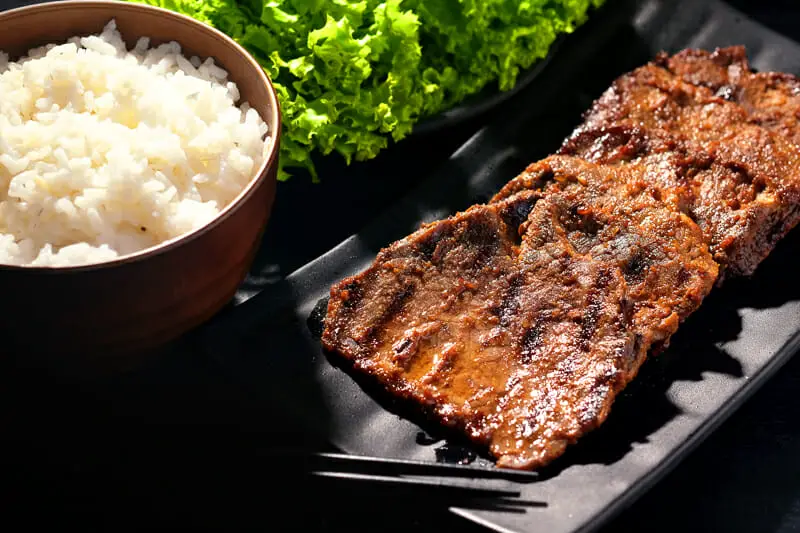Korean BBQ is picking up steam in the United States – sitting at a restaurant and cooking your own food seems appealing to many, and makes for a great social gathering of friends. This Korean Beef Bulgogi will make you think you’re at a Korean BBQ restaurant.
MEAT ON FIRE – FROM MAEKJEOK TO NEOBIANI
Beef bulgogi – which literally means ‘fire meat’ is a dish whose origins go way back to 2nd and 3rd century, to the time of the Koguryo dynasty, an empire which took in all of today’s North Korea, as well as some of the south and a big chunk of Manchuria that bleeds into modern-day China and Russia.
In its earliest form, today’s wafer-thin Korean bulgogi (which can now be found in both Koreas) was more like a kebab – chunks of meat soaked in sauce then lined up on a skewer and grilled over a fire. This preparation, known as ‘maekjeok’, morphed into a court dish called ‘neobiani’ during the time of the Joseon Dynasty (1392-1910) that consisted of thinner, wider, flatter slices of beef that were nonetheless still marinaded. Meat being a luxury commodity, neobiani would only have been eaten by royalty and the upper echelons of the ruling classes.

BULGOGI BEEF AND COW-LIDAYS
Although considered to be an excellent bite, beef was not widely farmed on the peninsula until the 20th century, as cows were mostly used as work animals. Cattle were highly regarded, holding the status of ‘saenggu’, which were servants who assisted with the livelihood of a family. In fact, cows were so appreciated that they were even given their own holiday on the first day of the lunar year: a bovine day off, cows were extra-specially loved and given festive food on this auspicious day.
Natural resources in Korea took a hit following Japanese annexation in 1910, after which the country remained occupied until its liberation at the end of Word War II. It was an ugly period; Japanese efforts to assimilate Korea into a home territory resulted in a sharp curtailment of Koreans’ legal and cultural rights. While the Japanese usurped the country’s economy, workforce and resources, many Koreans fell into poverty.
After the Japanese left, Korea was split in two by a political tug-of-war between Russia and the US, each of which had a very different vision for the future of the country. This division led to the Korean War of 1950-3, and all of this upheaval served as the backdrop for the final transformation of bulgogi into its current svelte form.
If you love rice recipes
If you love rice, you might want to also check our our Jordanian Rice Pilaf (Mansaf), or our Cantonese Fried Rice recipe
THE RESURGENCE OF BULGOGI
The 1930s saw an increase in the use of cattle for beef production, especially in urban areas like Gyeongseong and Pyongyang, and indeed Pyongyang in particular was known for its quality beef which was considered to be of a high standard. Beef bulgogi from Pyongyang became a delicacy that reached the restaurants of Seoul in the 1940s. Still, the number of cows in the country was low (557,000 in 1947 and 392,000 in 1953 after the Korean War) and beef continued to be a luxury food only consumed in restaurants or for special occasions. Any instances of grilled bulgogi were often replaced by a brothy version where the addition of water, stock and some choice veg made the meat go that much further in times of lack.
In the 1950s and 1960s, North Korea’s economy was much stronger than that of the south and it wasn’t until after the industrial reforms of the late 1960s that South Korea began to really modernise and strengthen economically. The rise in wealth meant more food on the table at home and finally bulgogi made its entrance into the dining rooms of middle class families.
ABOUT THE RECIPE
This Korean beef bulgogi has a very particular flavor that leaves us hankering for more, and it’s easy to make in big batches. The key to nailing the taste lies in the marinade sauce, whose major ingredients are Korean pear, soy sauce and mirin, as well as the indispensable Gochujang (on Amazon).
Gochujang is a salty Korean chilli paste made from red chili, fermented soybeans and glutinous rice and is used in a lot of Korean cooking (especially with pork although we are stealing it for our beef marinade in this instance). We recommend trying your best to source it – you can easily order it online if you don’t have a Korean or Asian supermarket nearby – as it’s really what gives the bulgogi marinade its umami kick. Substitute with regular chili sauce only if stranded on a desert island.
If you don’t have a barbecue at home, you can also grill your beef on a griddle pan on the stove, and if you don’t have access to Korean pears, you can very easily switch out an apple or a regular pear, or even apple or pear juice.
MIXING THE MARINADE
It’s best to let your beef marinade for a long time, at least overnight, so the majority of the prep for this Korean beef bulgogi recipe should happen the night before. Get all your ingredients together.

Slice your beef carefully to make it as thin as possible, just a few millimeters per piece. If you feel your knifemanship isn’t up to the task, ask your butcher to do the slicing for you.

Core your Korean pear (or similar fruit) and roughly chop into cubes. There’s no need to peel it. The pear adds flavor but also helps to tenderize the meat.
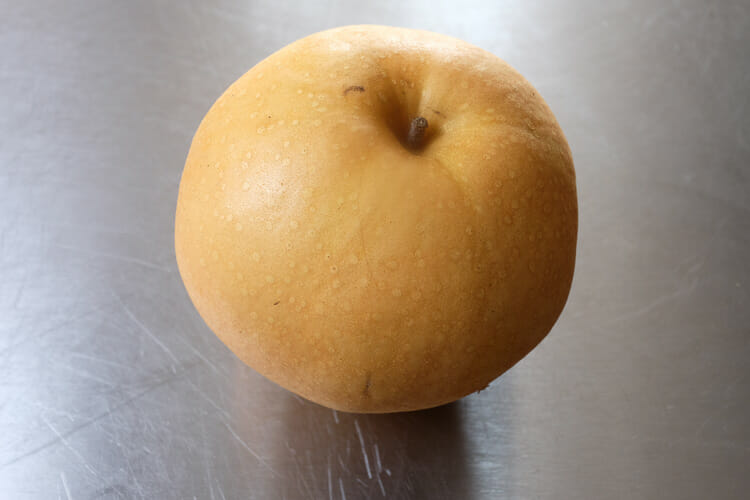
Make sure you have your Gochujiang ready and prepare a watertight excuse if you don’t.
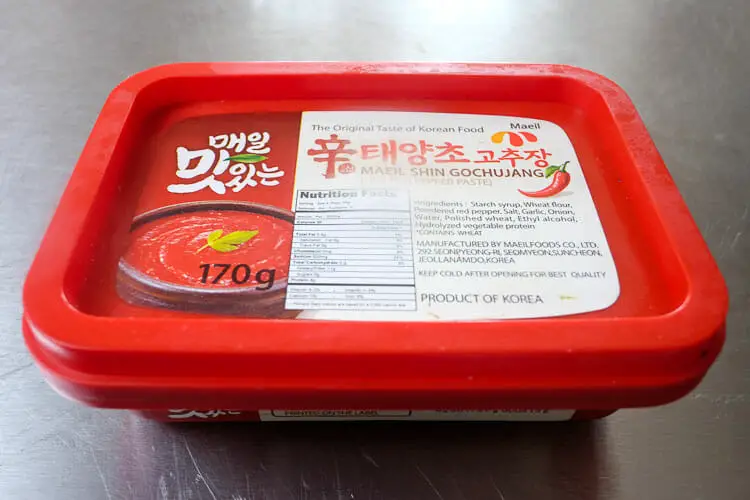
Put all the ingredients for the marinade (everything except the beef) into a blender and pulverize into a smooth sauce.
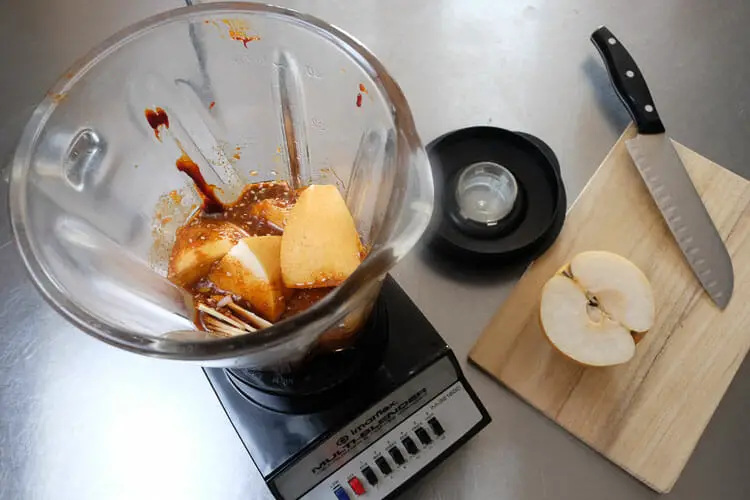
Place the beef slices in a bowl and pour the bulgogi marinade over the top. Make sure each slice of meat is well drenched in the sauce. Cover the bowl and leave in the refrigerator overnight to soak in.

When you’re ready to cook, heat and oil up the grill or a grill pan on the stovetop. Shake each slice of beef so that the excess sauce falls away, and place on the grill. One minute on each side of the cut should suffice for a perfect finish. Be careful not to over-cook the meat, or it’ll become too dry.

Serve right away while the beef is still hot. Plain rice is a good traditional accompaniment.

We also like eating the bulgogi with lettuce leaves, making a wrap with the entire leaf.

Jal meokkesseumnida!
OUR TAKE ON THE RECIPE
We love the simplicity of this Korean beef bulgogi, and the well-balanced sweet-spicy flavors. It’s familiarly Asian in its ingredients – ginger, sesame oil, soy sauce – and is best served directly from the grill.
Keeping the meat soft is important and we recommend getting a good cut like sirloin or tenderloin, as well as keeping a hawkish eye over the grill while the meat is cooking, so as not to let it go on for too long and become brittle.
There’s next to nothing we’d change about this particular bulgogi. The source recipe we were working from suggested a few variations, like the addition of onions, carrots or mushrooms to enhance the taste, which might make things more interesting. We also wonder how this recipe might pan out should one wish to substitute beef for fish, since a sturdier-fleshed fish like salmon or tuna could turn out well under this method too.
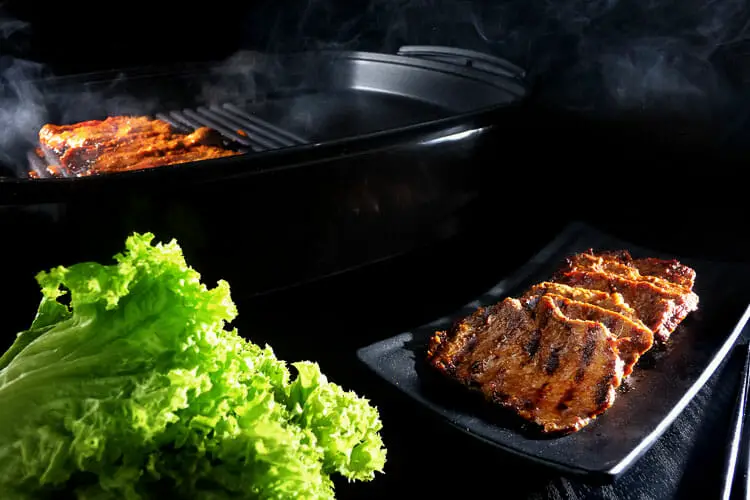

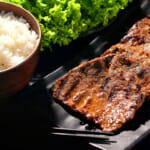
Korean Beef Bulgogi
- Total Time: 20 minutes
Ingredients
For the Meat:
- 1 kg beef sirloin, thinly sliced
For the Marinade:
- 1 Korean pear, cored and roughly chopped (or substitute with a regular apple or pear, or apple or pear juice)
- 1/4 cup brown sugar
- 1/4 cup soy sauce
- 1–2 tablespoons Gochujang (on Amazon) chili paste
- 2 tablespoons mirin
- 2 tablespoons sesame oil
- 1/4 cup chopped leeks
- 2 tablespoons sesame seeds
- 1 thumb-sized piece of ginger, thinly sliced
Instructions
Step 1: Prepare the Bulgogi Marinade
- To make the bulgogi marinade, combine all ingredients except for the beef in a blender. Process until smooth.
Step 2: Let the Marinated Meat Rest Overnight
- Pour the marinade over the beef slices and make sure they are completely smothered in the sauce. Cover and place in the refrigerator overnight.
Step 3: Break Out the Grill
- Finish the beef on a hot grill for about a minute on each side, shaking off any excess sauce from the meat first. If you don’t have a barbecue grill, a stove-top grill pan will work very well too.
- Prep Time: 10 min
- Cook Time: 10 min
